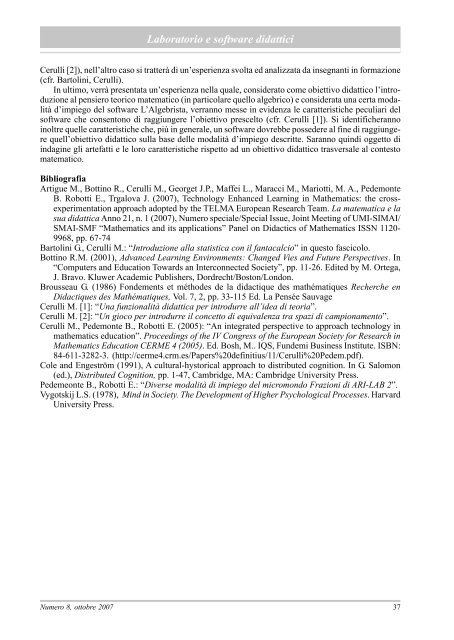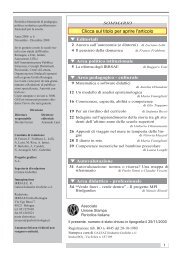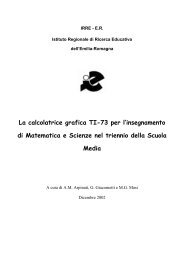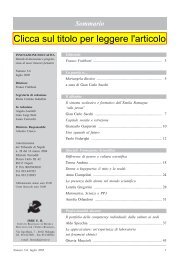Il laboratorio matematico-scientifico: suggerimenti ed esperienze
Il laboratorio matematico-scientifico: suggerimenti ed esperienze
Il laboratorio matematico-scientifico: suggerimenti ed esperienze
You also want an ePaper? Increase the reach of your titles
YUMPU automatically turns print PDFs into web optimized ePapers that Google loves.
Laboratorio e software didattici<br />
Cerulli [2]), nell’altro caso si tratterà di un’esperienza svolta <strong>ed</strong> analizzata da insegnanti in formazione<br />
(cfr. Bartolini, Cerulli).<br />
In ultimo, verrà presentata un’esperienza nella quale, considerato come obiettivo didattico l’introduzione<br />
al pensiero teorico <strong>matematico</strong> (in particolare quello algebrico) e considerata una certa modalità<br />
d’impiego del software L’Algebrista, verranno messe in evidenza le caratteristiche peculiari del<br />
software che consentono di raggiungere l’obiettivo prescelto (cfr. Cerulli [1]). Si identificheranno<br />
inoltre quelle caratteristiche che, più in generale, un software dovrebbe poss<strong>ed</strong>ere al fine di raggiungere<br />
quell’obiettivo didattico sulla base delle modalità d’impiego descritte. Saranno quindi oggetto di<br />
indagine gli artefatti e le loro caratteristiche rispetto ad un obiettivo didattico trasversale al contesto<br />
<strong>matematico</strong>.<br />
Bibliografia<br />
Artigue M., Bottino R., Cerulli M., Georget J.P., Maffei L., Maracci M., Mariotti, M. A., P<strong>ed</strong>emonte<br />
B. Robotti E., Trgalova J. (2007), Technology Enhanc<strong>ed</strong> Learning in Mathematics: the crossexperimentation<br />
approach adopt<strong>ed</strong> by the TELMA European Research Team. La matematica e la<br />
sua didattica Anno 21, n. 1 (2007), Numero speciale/Special Issue, Joint Meeting of UMI-SIMAI/<br />
SMAI-SMF “Mathematics and its applications” Panel on Didactics of Mathematics ISSN 1120-<br />
9968, pp. 67-74<br />
Bartolini G., Cerulli M.: “Introduzione alla statistica con il fantacalcio” in questo fascicolo.<br />
Bottino R.M. (2001), Advanc<strong>ed</strong> Learning Environments: Chang<strong>ed</strong> Vies and Future Perspectives. In<br />
“Computers and Education Towards an Interconnect<strong>ed</strong> Society”, pp. 11-26. Edit<strong>ed</strong> by M. Ortega,<br />
J. Bravo. Kluwer Academic Publishers, Dordrecht/Boston/London.<br />
Brousseau G. (1986) Fondements et méthodes de la didactique des mathématiques Recherche en<br />
Didactiques des Mathématiques, Vol. 7, 2, pp. 33-115 Ed. La Pensée Sauvage<br />
Cerulli M. [1]: “Una funzionalità didattica per introdurre all’idea di teoria”.<br />
Cerulli M. [2]: “Un gioco per introdurre il concetto di equivalenza tra spazi di campionamento”.<br />
Cerulli M., P<strong>ed</strong>emonte B., Robotti E. (2005): “An integrat<strong>ed</strong> perspective to approach technology in<br />
mathematics <strong>ed</strong>ucation”. Proce<strong>ed</strong>ings of the IV Congress of the European Society for Research in<br />
Mathematics Education CERME 4 (2005). Ed. Bosh, M.. IQS, Fundemi Business Institute. ISBN:<br />
84-611-3282-3. (http://cerme4.crm.es/Papers%20definitius/11/Cerulli%20P<strong>ed</strong>em.pdf).<br />
Cole and Engeström (1991), A cultural-hystorical approach to distribut<strong>ed</strong> cognition. In G. Salomon<br />
(<strong>ed</strong>.), Distribut<strong>ed</strong> Cognition, pp. 1-47, Cambridge, MA: Cambridge University Press.<br />
P<strong>ed</strong>emeonte B., Robotti E.: “Diverse modalità di impiego del micromondo Frazioni di ARI-LAB 2”.<br />
Vygotskij L.S. (1978), Mind in Society. The Development of Higher Psychological Processes. Harvard<br />
University Press.<br />
Numero 8, ottobre 2007 37







